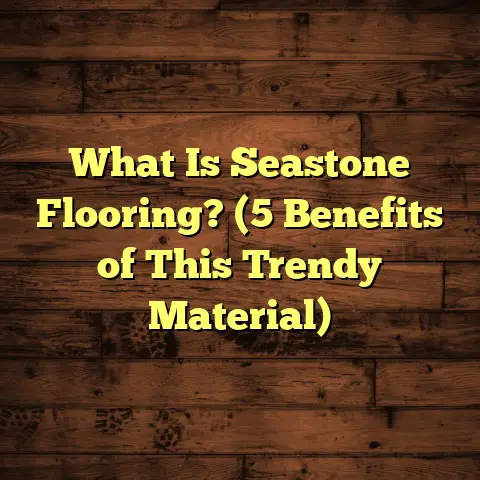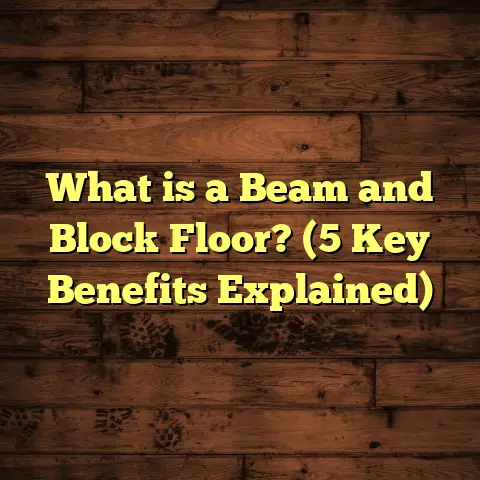What is Pergo Style Flooring? (5 Benefits for Modern Homes)
When I first started working with flooring, the challenges posed by different climates really shaped how I approached selecting materials. Living in a place where humidity swings can be dramatic, I quickly learned that not every flooring type holds up well over time. That’s when I got curious about options that combine durability with style without breaking the bank. One choice that caught my attention early on was Pergo style flooring, and it’s been a game-changer for many homes I’ve worked on.
What Is Pergo Style Flooring?
So, what exactly is Pergo style flooring? Simply put, it’s a type of laminate flooring designed to mimic the look of real hardwood floors but at a fraction of the cost and maintenance effort. The original Pergo brand pioneered this style in the 1970s, creating a product with a tough wear layer that resists scratches and dents. Over the years, the technology behind this flooring has improved massively.
Pergo style flooring typically consists of several layers: a durable top wear layer made from melamine resin, a high-resolution photographic layer that shows the wood grain or other patterns, a core layer usually made of high-density fiberboard (HDF), and a backing layer to stabilize the floor. This construction provides both resilience and realistic aesthetics.
I’ve installed Pergo style flooring in homes with kids and pets, and honestly, it holds up better than many hardwoods under heavy use. It’s also much less sensitive to moisture, which is a huge plus if your climate swings between dry and humid seasons.
The History and Evolution of Pergo Style Flooring
I remember reading about how Pergo floors came about when Perstorp AB, a Swedish company, introduced this laminate flooring in 1977. The concept was revolutionary back then—providing an affordable alternative to hardwood while offering resistance to wear and tear. At first, the appearance wasn’t perfect—early laminates looked somewhat artificial. But as digital printing technology advanced, manufacturers began producing laminate planks that convincingly replicated wood grains and textures.
Modern Pergo style floors now incorporate embossed finishes that add tactile realism. Some even have beveled edges to mimic traditional hardwood plank joints. This evolution makes them an attractive choice for homeowners who want the look of hardwood but without the drawbacks like high cost or maintenance hassles.
How Pergo Style Flooring Differs From Other Laminate Floors
Not all laminate floors are created equal. When I first started using laminate flooring in projects, I noticed big differences in quality between brands.
- Wear Layer Thickness: Pergo style floors often have thicker wear layers (typically 0.3mm or more) compared to cheaper laminates that might have just 0.2mm or less.
- Core Material Quality: The HDF core in Pergo floors tends to be denser and more stable, improving durability and moisture resistance.
- Locking System: Many Pergo styles use advanced click-lock systems that make installation easier and ensure tight plank connections.
- Warranty: Pergo products generally come with longer warranties (up to 25 years residential) which shows confidence in their durability.
Having tried both low-end laminates and Pergo-style options across multiple jobs, I can say the difference is clear when it comes to longevity and appearance retention.
Comparing Flooring Options I’ve Tried
When I first started flooring projects, hardwood was my go-to. It just has that classic look everyone loves. But over time, I noticed a few drawbacks: hardwood can warp with moisture changes and needs regular refinishing to keep it looking fresh. Plus, installation and material costs add up quickly.
Vinyl flooring was another option I explored. It’s waterproof and budget-friendly but often lacks the realistic wood feel that many homeowners want. Plus, cheaper vinyl can look plastic-y or dull.
Then came laminate and specifically Pergo style flooring. Compared to traditional laminate, Pergo floors have better locking systems and more durable wear layers. I found they scratch less, don’t fade as fast in sunlight, and handle moisture better. For example, in a recent project in a humid area of Florida, my client’s Pergo style floor stayed intact and beautiful despite the high humidity — something hardwood would have struggled with.
Hardwood vs. Pergo Style Flooring
Hardwood floors have an undeniable charm—natural warmth, unique grain patterns, and the ability to refinish multiple times over their lifespan. However:
- Hardwood prices average $8-$15 per square foot installed.
- They require sealing or finishing after installation.
- Sensitive to moisture and prone to warping.
- Need sanding/refinishing every 7–10 years.
- Can dent or scratch easily with pets or heavy furniture.
On the flip side:
- Pergo style flooring costs are significantly lower ($3-$5 per square foot installed).
- No refinishing needed; just surface cleaning.
- Much more resistant to dents and scratches.
- Water-resistant cores help prevent warping.
- Easier to install yourself or with minimal labor.
I once helped a client who loved hardwood but had two large dogs. She was tired of sanding scratches every few years. Switching to Pergo style flooring gave her the wood look she wanted with peace of mind about wear.
Vinyl vs. Pergo Style Flooring
Vinyl flooring has surged in popularity due to waterproof properties and affordability:
- Costs range from $2-$7 per square foot installed.
- 100% waterproof options available.
- Softer underfoot compared to laminate or hardwood.
- Can have shiny surfaces that don’t feel natural.
- Susceptible to tears or gouges from sharp objects.
Pergo style laminate floors are less water-resistant than vinyl but offer:
- Better wood-look textures.
- Higher resistance to scratches/dents.
- A more rigid feel underfoot (some prefer this).
- Often longer warranty periods.
In areas like kitchens or bathrooms where water exposure is high, vinyl might be better—but for living areas or bedrooms where style matters more, I lean toward Pergo style laminate.
Carpet vs. Pergo Style Flooring
Carpet obviously provides softness and warmth unmatched by hard surfaces but:
- Traps dust and allergens.
- Stains easily.
- Needs regular deep cleaning.
- Can look dated compared to modern floors.
Pergo style flooring offers a clean look that hides dirt well (especially darker tones) and is simple to maintain with sweeping or mopping.
I recall a client switching from carpet in their living room to Pergo style laminate—she loved how fresh the space felt afterward without sacrificing comfort because she added area rugs for coziness.
5 Benefits of Pergo Style Flooring for Modern Homes
1. Durability That Handles Everyday Life
One thing I always ask clients is how much foot traffic their floors will see. For busy families or pet owners, durability matters. Pergo style flooring has a thick wear layer engineered to resist scratches, scuffs, and stains. According to industry tests, some Pergo brands offer abrasion resistance ratings up to AC4 or AC5—meaning they can handle commercial-level traffic.
I remember a family with two dogs who installed Pergo style flooring in their living room. A year later, the floor still looked fantastic despite daily scratches from paws. This durability saves money in the long run since you won’t need to replace or refinish floors as often.
Real Data On Wear Resistance
The Abrasion Criteria (AC) rating system helps measure laminate durability:
| AC Rating | Use Case |
|---|---|
| AC1 | Moderate residential use |
| AC2 | General residential use |
| AC3 | Heavy residential / light commercial |
| AC4 | General commercial use |
| AC5 | Heavy commercial use |
Most Pergo style laminate floors fall around AC3–AC5 depending on model.
2. Moisture Resistance for Variable Climates
Humidity and spills can ruin hardwood floors fast. With Pergo style flooring, the core materials and protective top layers reduce water absorption significantly. Some newer Pergo styles even come with water-resistant cores.
In my experience working in climates like the Pacific Northwest or parts of Canada where dampness is common, Pergo style flooring performed much better than traditional hardwood or even standard laminates. It’s not completely waterproof like some vinyls but can withstand normal household moisture without warping or swelling.
Personal Experience
One project in Seattle involved installing Pergo style flooring in a basement family room prone to dampness after rainstorms. We used water-resistant core planks with an additional sealant on edges during installation. After two years of testing with no visible damage, the client was thrilled.
3. Realistic Appearance Without the Cost
One question I get asked a lot: “Will laminate ever look as good as real wood?” Honestly, technology has come so far. High-definition printing and textured finishes on Pergo style floors make them almost indistinguishable from real hardwood at a glance.
In one case, I installed a light oak Pergo style floor in a client’s urban loft. Guests couldn’t believe it wasn’t genuine oak until they looked closely! This kind of finish lets modern homes achieve that warm wood vibe without spending thousands per room.
How Texture Makes a Difference
Embossing techniques add grooves and grain patterns you can actually feel underfoot. This tactile realism makes a big difference versus flat laminates that just have printed images.
4. Easy DIY Installation
I’m a fan of projects that let homeowners save on labor costs when possible. Pergo style flooring often features click-lock installation systems that don’t require glue or nails. This design simplifies installation and allows even moderately handy folks to do it themselves.
I’ve personally installed several rooms using this system. It takes less time than traditional hardwood nailing or glue-down vinyl methods. Plus, if you mess up a plank or two, replacements are easy to swap out without major headaches.
Tips From My Installations
- Always acclimate your planks for at least 48 hours before installing.
- Use spacers along walls for expansion gaps.
- Cut planks carefully using a laminate cutter for cleaner edges.
- Lay planks parallel to main light sources for best visual effect.
5. Low Maintenance Requirements
Finally, maintaining a floor should never be a daily chore. With Pergo style flooring, sweeping or vacuuming regularly plus occasional damp mopping keeps it looking great. Unlike hardwoods that need refinishing every few years, these floors usually just need cleaning.
One homeowner told me she loves how she never has to worry about water marks like on her old wood floors — she just wipes up spills quickly and moves on.
Deeper Look: Cost Breakdown & Budgeting With FloorTally
Budgeting is one of those tricky parts of any renovation project—especially flooring where prices can vary widely depending on materials and labor markets.
A tool I rely on heavily is FloorTally because it lets me input local labor rates combined with material prices to get realistic total cost estimates quickly. It also factors in waste percentages which are easy to overlook but critical since cutting planks produces scrap.
Here’s roughly what I’ve seen for Pergo style flooring costs based on recent projects:
| Cost Item | Price Range (USD per sq ft) |
|---|---|
| Material | $1.50 – $3.50 |
| Installation Labor | $1.50 – $3 |
| Additional Supplies | $0.30 – $0.70 |
| Total Installed | $3 – $7 |
FloorTally helps me customize inputs based on room size, complexity (stairs add labor), waste factor (usually around 5–7%), and local wages.
Using this tool has saved me hours hunting down quotes plus it keeps budgets transparent for homeowners before ordering anything.
Unique Insights From My Flooring Projects
After years working directly with customers across different regions—from humid coastal towns to dry mountain areas—I’ve gathered some patterns worth sharing:
Climate Impact Lessons
- In humid climates like Florida or Louisiana, water-resistant laminate cores are essential; otherwise planks swell within months.
- Dry colder regions require acclimation periods before installation; otherwise planks shrink causing gaps.
- Homes with radiant floor heating benefit from laminate’s ability to conduct warmth evenly compared to carpet or vinyl.
Customer Preferences
Many clients want floors that fit their lifestyle:
- Families with kids want durable scratch-proof surfaces.
- Pet owners prioritize stain resistance from accidents.
- Seniors often prefer smooth floors for easier mobility aids use.
- Design-conscious buyers want textures resembling exotic woods at reasonable costs.
For many homeowners who don’t want ongoing maintenance hassles but still care about aesthetics, Pergo style flooring strikes a nice balance.
Case Study: Turning Around a Family Room Flooring Disaster
A few years ago, I was called into a home where the homeowners had installed cheap laminate themselves but faced bubbling planks after just six months due to moisture issues from poor subfloor prep.
We removed the damaged floor and installed high-quality Pergo style laminate with moisture barrier underlayment after properly drying the subfloor.
After three years, no signs of warping or damage—and they reported how much easier it was to clean compared to their previous carpeted floor.
This case reminded me how critical product quality combined with proper installation steps can be for long-term satisfaction.
Final Thoughts: Is Pergo Style Flooring Right For You?
If you’ve made it this far thinking about your own home’s floors—ask yourself these questions:
- Do you want hardwood looks without hardwood hassles?
- Is durability against kids/pets important?
- Does your climate subject floors to moisture swings?
- Would you try installing some or all yourself?
- Is budget a priority but you still want good quality?
If yes to most of these, Pergo style flooring could be exactly what you need.
I’m happy to share more detailed advice tailored specifically for your home conditions or walk you through cost planning using tools like FloorTally so you know what to expect before starting work.
Feel free to reach out anytime with questions—it’s one of my favorite topics!





